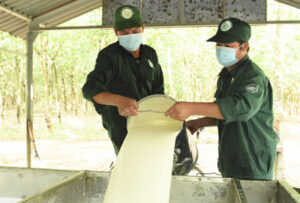Cambodia increases rubber exports for first two months of 2023
Phnom Penh, Cambodia – Cambodia netted $79.370 million from the export of natural rubber latex and wood in the first two months of 2023, marking a slight increase year-on-year, even amid a decline in prices on international markets for the locally-produced white sap, according to the Ministry of Agriculture, Forestry and Fisheries reports the Phnom Penh Post.
Agriculture ministry data obtained by The Post on March 15 showed that exports of rubber latex and wood in the January-February period respectively reached $79.062 million and $307,296. For comparison, the ministry’s General Directorate of Rubber (GDR) had put the rubber-latex export figure for the year-ago period at $76.88 million.
The average per-tonne value of the rubber latex exports over the first two months of 2023 came to $1,349, down $236 on-year.
Domestically, the average going-rate for rubber from smallholder farmers in February was in the range of 4,500-5,000 riel ($1.12-1.25) per kilogramme for 100 per cent dry rubber content (DRC 100%) latex – down 286 riel month-on-month – and 2,000-3,100 riel for lump latex (DRC 50%), down 181 riel, ministry data indicated.
GDR director-general Him Aun commented to The Post on March 15 that the Cambodian latex market is almost entirely dependent on overseas markets, adding that without foreign buyers, overall demand and prices plunge.
He pinned the falling prices of rubber exports on this reliance, as well as a supply glut amid weakening demand, inflation concerns, rising US interest rates, the Russo-Ukrainian conflict, and fallout from geopolitical turmoil.
In recent years, there have been minimal positive developments regarding the cultivation of rubber trees or the expansion of plantation areas thereof, he rued.
Aun had told The Post in October that the main buyers of Cambodian rubber are China, Vietnam, Singapore, Malaysia, Japan, South Korea and the EU.
Men Sopheak, director of rubber grower-cum-exporter Sopheak Nika Investment Agro-Industrial Plants Co Ltd, previously told The Post that economic spillovers from the Ukraine conflict and the Taiwan issue are hurting demand and are at the root of falling global rubber prices.
“We know that the Chinese market alone accounts for 70-80 per cent of the world’s total demand, which has also been driven down by problems in Europe,” he explained.
The GDR reported that as of end-2022, Cambodia had 404,578ha dedicated to rubber production, with 315,322ha or 77.94 per cent mature and tapped for latex.
In 2022, the Kingdom netted $531.864 million from the export of natural rubber latex and wood, down 12.85 per cent over 2021. Individually, rubber latex accounted for $527.775 million, and rubber wood for $4.089 million, according to the general directorate.

